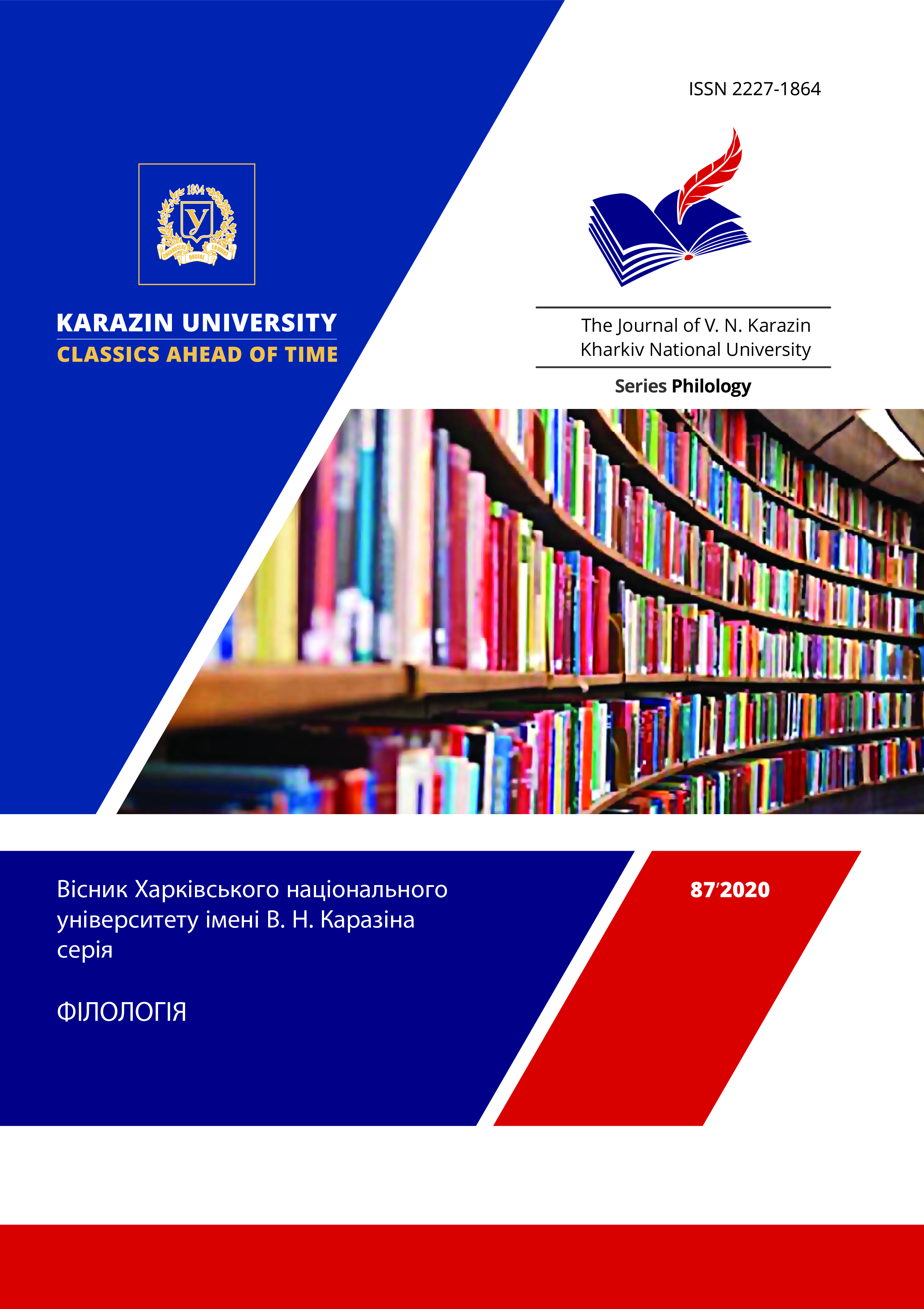Intentional paronymy in the Russian linguoculture
Abstract
The purpose of this study is to identify and systematize speech-behavioral situations (SBS) and speech-cultural scripts (scenarios) (SCS) of intentional paronymy, which traditionally include paronomasia and paronymic attraction, in the Russian linguocultural space. The object of study is paronyms used intentionally in various speech-behavioral situations of the Russian linguocultural space. The subject of the research is the originality of the system of speech-behavioral situations and the speech-cultural scripts caused by them provided that paronymy is intentionally used. The facts were investigated based on the Russian paronyms dictionaries. As a result of the work carried out, it was possible to show that in situations of intentional paronymy, two types of speech-behavioral tactics (SBT) can be used: the tactics of intentional paronymic replacement / substitution / error and the tactics of artistic design of speech. The author's conclusions are as follows: firstly, speech-behavioral situations of the intentional use of paronymy arising in the tactics of intentional paronymic substitution / error are a slip of the tongue, a misspelling, a mishearing, a misreading with possible speech-cultural scenarios of jokes, satire, irony, humorous or comic overtones, as well as overtones of condemnation, resentment, humiliation, ridicule, adventure, deception and others. In this case, only the wrong component of the paronymic opposition organized according to the principle of the „right” // „wrong” dichotomy is used. An exception is the mishearing situation, where both components of the paronymic pair are represented. Secondly, speech-behavioral situations arising in the tactics of artistic design of speech using paronymy are patronymic convergence and paronymic rhyming. These two speech-behavioral situations are accompanied by a speech-cultural script of enhancing the artistry and / or expressiveness of the text and the SCS of described assessment. In speech-behavioral situations of patronymic convergence and paronymic rhyming, at least two components of the paronymic series are represented, since intentional paronymy appears in these situations as a binary stylistic device.
Downloads
References
Vereitinova, M. M. (2011). Lingvometodicheskoye opisaniye aktualizirovannoy leksiki v tselyakh prepodavaniya russkogo yazyka kak inostrannogo (na materiale paronimov-prilagatel'nykh): Author’s thesis. Moscow: Lomonosov Moscow State University. [in Russian]
Vereshchagin, Ye. M., Kostomarov, V. G. (2005).Yazyk i kul'tura [Language and Culture]. Moscow: Indrik. [in Russian]
Vishnyakova, O. V. (1974). Paronimy v russkom yazyke [Paronyms in the Russian language]. Moscow: Vysshaya shkola Pub. Co. [in Russian]
Vishnyakova, O. V. (1984). Slovar' paronimov russkogo yazyka [Dictionary of the Russian paronyms]. Moscow: Russkiy yazyk Pub. Co. [in Russian]
Gorushkina, A. V. (2019). Lingvokul'turemy v structure sovremennogo poeticheskogo diskursa setevogo avtora Ali Kudryashevoy: funktsional'nyy aspekti zucheniya: Thesis. Cherepovets: Cherepovets State University. [in Russian]
Grigor'yev, V. P. (1979). Paronimicheskaya attraktsiya. Poetika slova. Moscow: Nauka Pub. Co., 251–299. [in Russian]
Yevgrafova, A. A. (1975). Paronimiya v sovremennom russkom yazyke: Author’s thesis. Kiev: State M. Gor'kiy pedagogical institute. [in Russian]
Zinov'yeva, Ye. I. (2016). Lingvokul'turologiya : ot teorii k praktike. St. Petersburg: Nestor-Istoriya Pub. Co. [in Russian]
Ivanova, D. A. (2013). Paronymy in a number of related phenomena of the modern Russian language. Philology and culture. Kazan', no. 4 (34), 52–56. [in Russian]
Isachenko, A. V. (1973). Iz nablyudeniy nad «novoy rifmoy». Slavic poetics: Essays in Honor of Kiril Taranovsky [From the observation of the “newrhyme”]. The Hague-Paris, 208–226. [in Russian]
Kritenko, A. P. (1974). Paronimiya i yeyo rol' v yazyke: Author’s thesis. Kiev: Potebnia Institute of Linguistics. [in Russian]
Krysenko, T., Sukhanova, T. (2019). Paronimiya v nauchnoy terminologii na zanyatiyakh po russkomu yazyku kak inostrannomu. Naukoví zapysky. Seríya: Fílolohíchní nauky [Paronimy in scientific terminology in the course of teaching Russian as a foreign language. Scientific Notes. Series: Philological sciences] Kropyvnytskyy: Volodymyr Vinnychenko Central Ukrainian State Pedagogical University, vol. 175, 39–44. [in Russian]
Mykhaylenko-Zoto, O. O. (2019). Pryntsypy dyferentsíatsii paronimiv u tekstakh riznykh styliv. Mova [Principles of paronyms’ differentiation in texts of different styles. Language]. Odessa: Astroprint, no. 32, 55–61. DOI: 10.18524/2307-4558.2019.32.187798. [in Ukrainian]
Polovnikova, V. I. (1988). Leksicheskiy aspect prepodavaniya russkogo yazyka kak inostrannogo na prodvinutom etape. Moscow: Russkiy yazyk Pub. Co. [in Russian]
Ponomaryova, O. B. (2011). Mnogoznachnost' vs. neodnoznachnost' gazetnykh zagolovkov kak kognitivnyy paradoks (na materiale tabloidnoy pressy Rossii i Velikobritanii). Voprosy lingvistiki, pedagogiki I metodiki prepodavaniya inostrannykh yazykov: collection of articles. Izhevsk: Udmurt University, 216–222. [in Russian]
Prokopchik, O. D. (2005). Semanticheskiye mekhanizmy i pragmaticheskiye funktsii paronimii: Author’s thesis. St. Petersburg. [in Russian]
Sannikov, V. Z. (2002). Russkiy yazyk v zerkale yazykovoy igry. 2nd ed., corrected and amended. Moscow: Yazyki slavyanskoy kul'tury Pub. Co .[in Russian]
Samoylov, D. (2005). Kniga o russkoy rifme. 3rd ed. Moscow: Vremya Pub. Co. [in Russian]
Tkachenko, L. P. (1989). Paronimicheskaya attraktsiya kak rechevoy priyom. Rechevyye priyomy i oshibki, tipologiya, derivatsiya i funktsionirovaniye: collection of scientific papers. Moscow: Institute of Linguistics, USSR AS, 126–132. [in Russian]
Sharapilova, E. A. (2000). Fonosemantika v lirike M. I. Tsvetayevoy: Thesis. Makhachkala. [in Russian]
Yunyazov, R. Yu. (2014). Kalambur v zagolovkakh gazet kak sredstvo privlecheniya vnimaniya auditorii. Filologiya i literaturovedeniye: Elektronnyy nauch.-prakt. zhurnal [A pun in the headlines as a means of attracting the attention of the audience. Philology and literature: Electronic scientific & practical journal]. Saransk, 2014. Retrieved from: http://philology.snauka.ru/2014/08/893 [in Russian] (2020, october, 18).
Yanko-Trinitskaya, N. A. (1979). K izucheniyu paronimov. Russkiy yazyk v shkole. Moscow, 5, 98–101. [in Russian]




